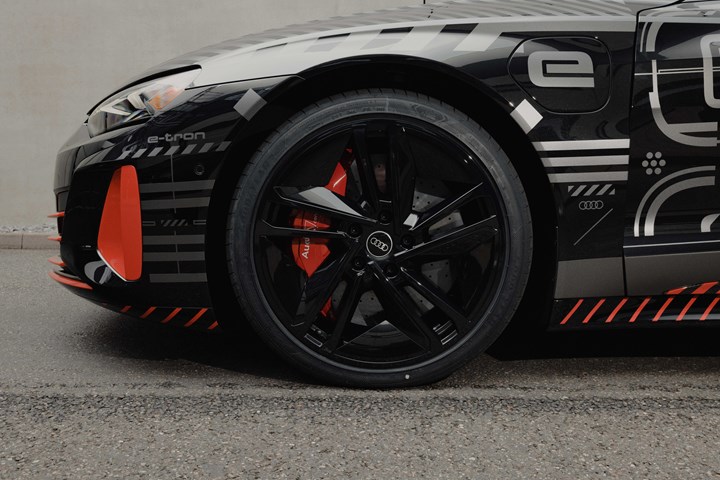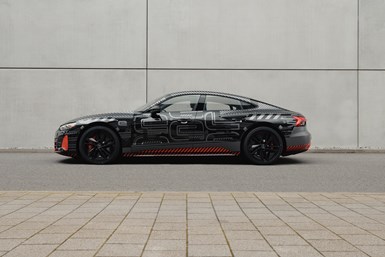Pretend Your Audi EV Is the Prototype
While camouflage car coverings are meant to disguise surfaces of development vehicles, what Audi is doing to the RS e-tron will turn a whole lot of heads — and it is an electric vehicle that you can have in your own driveway.

Not only does the limited-edition RS e-tron GT project_513/2 feature an exterior wrap, but there are special black finished 21-inch wheels and front and rear ceramic brakes painted red.
Photo Credit: All photos by AudiAlthough Audi of America had a 47% growth in its battery electric vehicle sales in 2022 compared to 2021, its third consecutive year of year double-digit growth for EVs—with a total of 16,177 units sold (among the e-tron, Q4 e-tron, e-tron Sportback, e-tron GT, and Q4 Sportback e-tron), the company is looking at ways to boost sales of its EVs.
One of the ways it is doing this is with finishing.
And although it isn’t going to move the sale’s needle a whole lot—it is limiting sales to a total of 75 units in the U.S., and will be available only in the U.S.—the 2023 RS e-tron GT project_513/2 will unquestionably be sold out in a blink its base $179,900 MSRP notwithstanding.
Why?
Well, the fact that this two-motor vehicle that produces 637 hp can go from 0 to 60 mph in 3.1 seconds doesn’t hurt.

While prototype vehicles that are disguised with paint, wraps, canvas and other things that are meant to break up the lines or to confuse the cameras of spy photographers, with the RS e-tron GT project_513/2 Audi is using camo to its advantage—sales advantage.
But because the RS e-tron GT project_513/2 appears to be a prototype thanks to the use of a camouflage wrap that is modeled on the graphics used when the car was undergoing global prototype testing.
The wrap is applied at the factory in Brussels, Belgium, where the vehicle is built.
It is a breathable, anti-static material that has the original red and black color scheme printed on the surface.
Inside, Too
And interior finishing is changed, as well.
The project_513/2 has the first use of the color red for the four-ring Audi logo. That red is used to paint the air vents on the inside of the car.

Note how the interior surfaces, especially on the instrument panel, echo the exterior camo pattern. That IP surface includes carbon fiber, a special foil and a glass-like material.
Another exterior echo on the interior are camo graphics on the instrument panel. It includes carbon fiber inlays. There is a “partial matting” process used, which involves using a special foil to mask the base component that is then precisely (primarily) hand cut to reveal the underlying surface. Then a glass media material is applied over that in order to provide a consistent look.
Given that, somehow that $179,000 price tag doesn’t look so high, especially when you take into account things like an embossed leather armrest; ceramic brakes; carbon fiber roof, exterior door inlays, mirror caps, and door sills; and even the project_513/2 logo etched on the rear quarter glass.
The RS e-tron GT project_513/2 goes on sale this spring. Good luck trying to get one of the 75.
RELATED CONTENT
-
Cylinder Coating for Improved Performance
Generally, when OEMs produce aluminum engine blocks (aluminum rather than cast iron because cast iron weighs like cast iron), they insert sleeves into the piston bores—cast iron sleeves.
-
On Audi's Paint Colors, the Lexus ES 250, and a Lambo Tractor
From pitching a startup idea to BMW to how ZF is developing and using ADAS tech to a review of the Lexus ES 250 AWD to special info about additive at Toyota R&D. And lots in between.
-
Paint Shop Innovations
.


.jpg;width=70;height=70;mode=crop)








